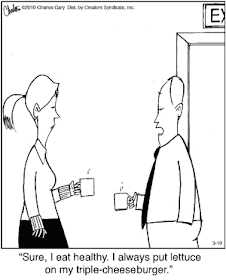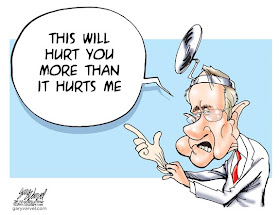
Economics, as a branch of the more general theory of human action, deals with all human action, i.e., with mans purposive aiming at the attainment of ends chosen, whatever these ends may be.--Ludwig von Mises
Wednesday, March 31, 2010
Tuesday, March 30, 2010
Monday, March 29, 2010
Saturday, March 27, 2010
Ron Paul on the Fed
What the Federal Reserve still fails to realize is that intervention in the economy is always harmful. Unlike the late French economist, Frederic Bastiat, the Fed only sees what is seen, the superficial results of its policies, and not what is unseen, the effects of its monetary intervention throughout the economy. Monetary inflation leads to malinvestment and causes the boom phase of the business cycle. Once the malinvestment is realized the bust phase occurs, and these malinvested resources need to be liquidated in order for the economy to recover. But the Fed actively works to prevent this liquidation and does everything in its power to continue inflating in order to prolong the boom. The first act of intervention begets the second and subsequent interventions, each bigger than the first, as each economic bust gets larger and more severe.
The idea that a handful of brilliant minds can somehow steer the economy is fatal to economic growth and stability. The Soviet Union's economy failed because of its central planning, and the United States economy will suffer the same fate if we continue down the path toward more centralized control. We need to return to sound money, bring back free markets, and rein in the Fed.
Friday, March 26, 2010
Thursday, March 25, 2010
Social Security Deficit
 This year, the system will pay out more in benefits than it receives in payroll taxes, an important threshold it was not expected to cross until at least 2016, according to the Congressional Budget Office...
This year, the system will pay out more in benefits than it receives in payroll taxes, an important threshold it was not expected to cross until at least 2016, according to the Congressional Budget Office...Although Social Security is often said to have a “trust fund,” the term really serves as an accounting device, to track the pay-as-you-go program’s revenue and outlays over time. Its so-called balance is, in fact, a history of its vast cash flows: the sum of all of its revenue in the past, minus all of its outlays. The balance is currently about $2.5 trillion because after the early 1980s the program had surplus revenue, year after year.
Now that accumulated revenue will slowly start to shrink, as outlays start to exceed revenue. By law, Social Security cannot pay out more than its balance in any given year.
sourceWednesday, March 24, 2010
Economic Role of Government
Government is a profoundly reactionary institution. It always favors its current clients – the present generation of taxpayers – over its clients of the future (who don’t pay taxes and don’t lobby). It provides protection against foreign invaders and domestic troublemakers. It also attempts to give its clients protection against the future.
Taxpayers want government to protect their existing assets…their businesses…their claims…their jobs…their franchises against all threats. In the modern world, most of those threats come in the form of economic and technological change. That’s why taxpayers demand subsidies and bailouts. It’s also why they like regulation. Anything that will keep change from diminishing what they’ve got.
A properly-functioning economy, as Schumpeter described it, is a process of incremental growth and also of creative destruction…in which old industries, old technologies and old institutions are blown up by change. This is what people pay their taxes to avoid. The present generation wants the government to “do something” to protect them from this process. It’s why they are perfectly happy to see the government take over the whole economy, if necessary, in order to prevent capitalism from happening.
Tuesday, March 23, 2010
Monday, March 22, 2010
Healthcare Bill and South Park

Magical thinking is alive and well in DC.
Chicago Fed Economic Activity Drops

The Dollar

International Trade: Balance of Payments

Sunday, March 21, 2010
Saturday, March 20, 2010
GDP v GDI

Fed economist Jeremy Nalewaik examined the differences in GDP and a closely-related measure, gross domestic income. GDP measures the output of the economy as the sum of expenditures — consumption, plus investment plus government spending plus net exports. GDI measures total income in the economy.
In theory, the two measures should equal one another, in practice they don’t quite, and Mr. Nalewaik argues that GDI is the better of the two.
He finds that when the Commerce Department’s Bureau of Economic Analysis revises its national income and product accounts, GDP figures move more closely inline with GDI. GDI also appears to have a stronger correlation with other economic indicators, and its recent movement around turning points suggests it more closely tracks the economy.
He notes that GDI fell far more sharply in the teeth of the recession, dropping at a 7.3% annual rate in the fourth quarter of 2008, and 7.7% in the first quarter of 2009. GDP, in comparison, fell by 5.4% and 6.4%. Moreover, while GDP showed the economy began to grow in last year’s third quarter, GDI showed it continued to contract. (Fourth-quarter GDI figures aren’t yet available.)
read the WSJ article or read Nalewiek's paper
Friday, March 19, 2010
Greenspan and "The Crisis"
Mr. Greenspan's reputation has been tarnished by the crisis. Widely hailed when he left office in January 2006 as one of the greatest central bankers ever, he is now blamed by many for advocating deregulation and low interest rates during the 1990s and 2000s.
WSJ article
Barry Ritholtz responds:
his incompetence as a regulator made his incompetence as a central banker even worse.
source
here is the Greenspan paper: The Crisis
Thursday, March 18, 2010
National Debt: Bush v. Obama
The debt now stands at $12.6 trillion. On the day Mr. Obama took office it was $10.6 trillion.
President George W. Bush still holds the record for the most debt run up on his watch: $4.9 trillion.
But it took him over four years to rack up the first two trillion dollars in debt.
It has taken Mr. Obama 421 days.
source
Wednesday, March 17, 2010
Tuesday, March 16, 2010
Monday, March 15, 2010
Sunday, March 14, 2010
A Complex Economy
Imagine the Rube Goldberg machine as a complex modern economy.
How many of you think this worked the first try?
And how many "unforeseen circumstances" still remain within the mechanism?
Is it appropriate to believe the economy can be managed efficiently?
read more here
Enchiladas

7" Flour Tortillas
1 pound ground chuck (80/20)
1 large sweet onion diced
2-10 ounce can enchilada sauce
1-16 ounce can Bush's black beans (drained)
1-12 ounce pack of shredded Mexican blend cheese
Directions: Brown meat with onions and drain. Add 15 ounces of enchilada sauce (reserve remaining 5 ounces), black beans, 8 ounces of cheese (reserve 4 ounces). Stir and heat.
Spoon 3 heaping tablespoons of beef, bean, and cheese mixture onto a tortilla. Fold and place face down in a greased Pyrex baking dish. Cover with sauce and cheese. Bake at 375 for about 20 minutes.
Saturday, March 13, 2010
Friday, March 12, 2010
Thursday, March 11, 2010
Carlos Slim: THe World's Richest Man
This year, the title of "World's Richest" went to Mexican telecom mogul Carlos Slim, with a net worth of $53.5 billion.
Slim, whose holding company America Movil contains a sprawling collection of telecom assets, is the first non-American to be declared Forbes' richest person since 1994, when Japanese real estate kingpin Yoshiaki Tsutsumi held that honor. (He has since disappeared from the list entirely).
But Slim's financial edge over Gates is, well, slim, at least by billionaire standards -- just $500 million. A $1 increase in Microsoft shares, the compilers of the Forbes list noted at a press conference Wednesday, could send Gates' net worth ahead of Slim's.
Also, were it not for his extensive philanthropy, Gates would have a net worth in the ballpark of $80 billion, Forbes' Matthew Miller estimated.
source
Wednesday, March 10, 2010
Tuesday, March 9, 2010
43% Have Less Than 10K for Retirement
The percentage of workers who said they have less than $10,000 in savings grew to 43% in 2010, from 39% in 2009, according to the Employee Benefit Research Institute's annual Retirement Confidence Survey. That excludes the value of primary homes and defined-benefit pension plans.
Workers who said they had less than $1,000 jumped to 27%, from 20% in 2009.
Confidence in ability to save enough for a comfortable retirement hovered at 16% of respondents, the second lowest point in the 20-year history of the survey.
source
Monday, March 8, 2010
Saturday, March 6, 2010
Deficit Projections

Greg Mankiw writes:
Making matters worse, these bleak budget projections are based on relatively optimistic economic assumptions. The administration forecasts economic growth of 3.0 percent from the fourth quarter of 2009 to the fourth quarter of 2010, followed by 4.3 percent the next year. By contrast, the Congressional Budget Office predicts growth of 2.1 percent and 2.4 percent for these two years. Lower growth would mean less tax revenue, larger budget deficits and a more rapidly increasing debt-to-G.D.P. ratio.
source
If the President’s proposals were enacted, the federal government would record deficits of $1.5 trillion in 2010 and $1.3 trillion in 2011. Those deficits would amount to 10.3 percent and 8.9 percent of gross domestic product (GDP), respectively. By comparison, the deficit in 2009 totaled 9.9 percent of GDP.
Measured relative to the size of the economy, the deficit under the President’s proposals would fall to about 4 percent of GDP by 2014 but would rise steadily thereafter. Compared with CBO’s baseline projections, deficits under the proposals would be about 2 percentage points of GDP higher in fiscal years 2011 and 2012, 1.3 percentage points greater in 2013, and above baseline levels by growing amounts thereafter. By 2020, the deficit would reach 5.6 percent of GDP, compared with 3.0 percent under CBO’s baseline projections.
CBO Estimates
2009: 1.413 trillion
2010 CBO baseline: $1360 billion
2010 CBO (Obama): $1500 billion
2011 CBO baseline: $995 billion
2011 CBO (Obama): $1341 billion
2012 CBO baseline: $641 billion
2012 CBO (Obama): $915 billion
Friday, March 5, 2010
Thursday, March 4, 2010
Jim Bunning , Welfare, and Atlas
So, Bunning blocks a welfare bill on the ground that the federal government shouldn’t be borrowing any more money. If it can’t afford to be providing the welfare, Bunning said, then it shouldn’t be spending more money.
The statist crowd went ballistic. The attacks were the standard ones whenever anyone objects to any welfare-state scheme: “He’s selfish, self-centered, and greedy. He hates the poor and loves the rich. He’s just grandstanding. The bill is only a small percentage of total spending and so it doesn’t make any difference in the larger scheme of things.”
But the statist reaction to Bunning’s move goes much deeper than that and is a perfect reflection of what the socialistic welfare state has done to the American people. Having been born and raised under the welfare state, American recipients of welfare largess, including those on Social Security, Medicare, Medicaid, unemployment, education grants, mortgage guarantees, and bailout and stimulus monies, honestly believe that they are entitled to continue receiving it for as long as they “need” the money...
This is what the welfare state has done to America. It has produced a real war among the American people — between those who produce and own their wealth and those who are trying to get their hands on other people’s money through the force of the state. The 19th-century French legislator Frederic Bastiat put it well when he indicated that under the welfare state, the government becomes a great fiction by which some people try to live at the expense of other people.
Wednesday, March 3, 2010
Capitalism v The Free Market
Economic Liberty Lecture Series: Sheldon Richman from The Future of Freedom Foundation on Vimeo.
Bryan Caplan responds:
If Sheldon were merely saying that libertarians' noun of choice should be "the free market," rather than "capitalism," he'd have a decent case. But for libertarians to reject "capitalism" as an alternate noun is overly defensive - and to announce that we "oppose capitalism" is completely confusing.
source
Stephan Kinsella responds:
I have myself for years now preferred the term anarcho-libertarian instead of anarcho-capitalist, mostly because libertarianism is about more than just free markets. But to the extent capitalism means the private ownership of the means of production–and I think this is a defensible meaning still–it is of course libertarian. We can expect any advanced libertarian society to be “capitalist” in that it would have an industrial, productive economy where the means of production is privately owned, characterized by the division and specialization of labor.
source
Tuesday, March 2, 2010
Happy Birthday, Murray

Today — March 2nd — is Murray Rothbard’s birthday. Had he lived, he’d be 84 years old today. And there’s sadness in that, because 84 in the world of today, though still a “ripe old age,” is not really all that old. Lots of people live to be 84. Even libertarians do it. Both Ludwig von Mises and Friedrich Hayek lived to be 92. Milton Friedman lived to be 94. Henry Hazlitt lived to be 98. In Radicals for Capitalism, his important 2007 book about the history of the modern American libertarian movement, Brian Doherty centers his story around what he describes as “[f]ive thinkers … without whom there would have been no uniquely libertarian ideas or libertarian institutions of any popularity or impact in America in the second half of the twentieth century … Ludwig von Mises, Friedrich A. Hayek, Ayn Rand, Murray Rothbard, and Milton Friedman.”
“Four men and one woman,” Doherty writes, “four Jews and one Catholic; four economists and one novelist; four minarchists … and one anarchist … two native-born Americans and three immigrants; two Nobel Prize winners and three who remained not only aloof from most professional and intellectual accolades but generated a heated hostility from cultural gatekeepers.” Doherty makes no mention of it, but there’s yet another facile point of comparison he might have used in discussing his five major figures — their longevity. For of his five major figures, three (Mises, Hayek, and Friedman) lived into their 90s. The other two — Rand and Rothbard — never made it to 80. Rothbard never made it to 70. It’s almost as though radicalism makes you die young. Mises, Hayek, and Friedman were minarchists — classical liberals, to be more precise.
Rand was a minarchist, too, but of a more radical stripe. She required that her limited, night-watchman State get along without any power of taxation, which she rightly regarded as theft. And Rothbard, who lived the shortest life of them all, was, of course, an anarchist, the only writer among them with the courage to assert boldly that the State didn’t need limiting, it needed abolishing.
Another way of putting this would be to say that Rothbard was the only pure libertarian among Doherty’s Big Five — not a classical liberal or even a more radical minarchist like Ayn Rand, but a thinker who saw the implications of the libertarian axiom, the nonaggression axiom, and unflinchingly accepted those implications, the only one among Doherty’s Big Five who was unafraid to follow his thinking where it must inevitably lead him. Brian Doherty calls Rothbard “the most uniquely and characteristically libertarian of libertarians; the one whose influence explains most about what makes the ideas, behavior, and general flavor of American libertarianism unique; the most illustrative and paradigmatic of the foundational figures of modern libertarianism.” It’s not for nothing that during the 1970s Rothbard came to be widely known as “Mr. Libertarian.”
listen (23:26)
If Murray Rothbard—free-market economist, anarchist philosopher, American historian, and inveterate activist—had never lived, the modern libertarian movement would have nowhere near its current size and influence. He inspired and educated generations of influential intellectuals and activists, from Leonard Liggio to Roy Childs to Randy Barnett. He helped form and/or shape the mission of such institutions as the Institute for Humane Studies, the Cato Institute, the Libertarian Party, and the Ludwig von Mises Institute (and wrote a regular column for Reason for more than a decade). His initially unique combination of a Randian/Aristotelian natural rights ethic, Austrian economics, anarcho-capitalism, fervent opposition to war, and a populist distrust of “power elites” both public and private have injected modern libertarianism with a distinct flavor distinguishing it from other brands of pro-market thought. It was a differentiation intensified by Rothbard’s bombthrowing polemical style.














 source
source


















